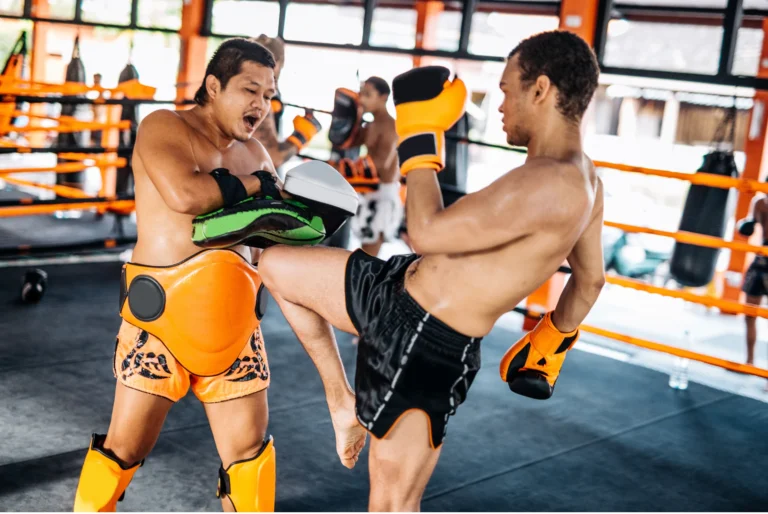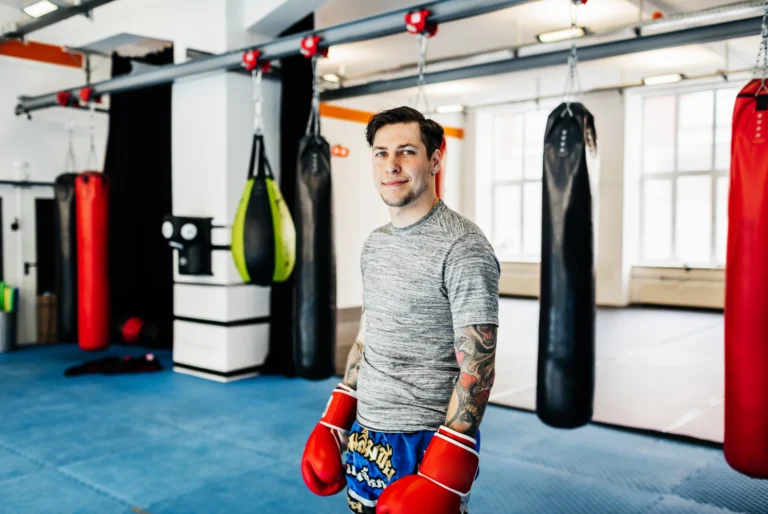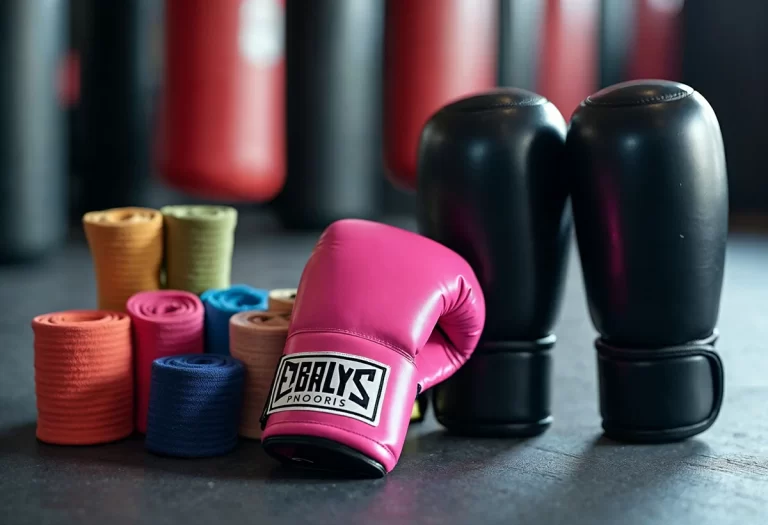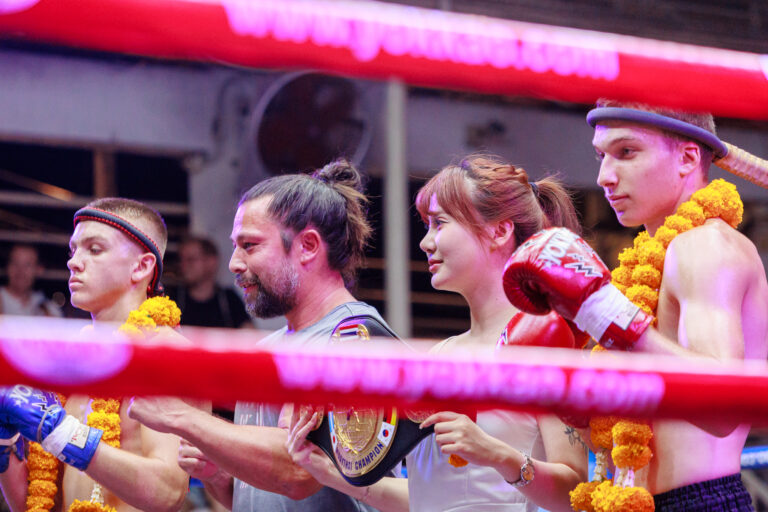The Muay Thai ring, known as “sanam muay” in Thai, transcends its function as a simple fighting arena. This sacred space embodies centuries of tradition, spiritual beliefs, and cultural reverence that define Thailand’s national sport. From precise dimensions standardized for international competition to entrance protocols preserving ancient customs, every element of the ring carries deep significance.
Understanding the Muay Thai ring reveals how modern athletic competition harmonizes with spiritual traditions dating back centuries. Professional fighters treat the canvas as hallowed ground, performing elaborate ceremonies before stepping through the ropes. Stadium visitors witnessing fights at venues across Thailand experience this unique intersection of sport, culture, and spirituality firsthand.
The Physical Structure of the Muay Thai Ring
Standard Dimensions and Shape
According to World Muay Thai Council regulations, the standard Muay Thai ring measures 6.1 meters (20 feet) on each side, forming a perfect square. This standardized dimension ensures consistency across professional competitions worldwide while maintaining traditional proportions used in Thai boxing for generations.
Ring size may vary slightly at smaller venues or training facilities, typically ranging from 5.5 to 7.3 meters per side. However, major stadiums like Rajadamnern and Lumpinee in Bangkok strictly adhere to the 6.1-meter standard for championship bouts. The square shape remains constant across all legitimate Muay Thai competitions, distinguishing it from circular wrestling rings or octagonal mixed martial arts cages.
Ropes and Corner Padding
Four thick nylon ropes surround the fighting surface, positioned at precise heights: 18 inches (45 cm), 30 inches (76 cm), 42 inches (107 cm), and 54 inches (137 cm) from the canvas. Each rope stretches taut between corner posts, wrapped in soft padding to prevent injury during clinch work near the edges.
Corner pads connect the ropes vertically at each post, providing cushioning where fighters sometimes get pressed during exchanges. The rope system creates defined boundaries while allowing fighters mobility to use the entire ring space. Traditional red and blue corners designate starting positions, with neutral corners providing refuge during standing eight-counts.
Canvas and Flooring System
The ring floor features canvas stretched over layered padding, creating a surface that balances firmness for footwork with cushioning for falls. Professional-grade rings use 1-2 inches of high-density foam padding beneath the canvas, providing shock absorption without compromising stability.
Canvas material must be non-slip to prevent dangerous footing issues during rapid directional changes. The surface receives regular cleaning and maintenance to ensure optimal grip. Unlike Western boxing rings with spring-loaded floors, Muay Thai rings maintain firmer surfaces that support the sport’s emphasis on kicks, knees, and dynamic movement patterns.
Cultural and Spiritual Significance
The Ring as Sacred Ground
Thai Buddhist traditions deeply influence Muay Thai culture, with the ring itself considered consecrated space. Before construction, traditional ceremonies often involve Buddhist monks blessing the site and materials. This practice transforms the fighting arena into sacred ground worthy of hosting the ancient martial art.
Fighters and spectators alike treat the ring with reverence. Pointing feet toward the ring or stepping on ropes disrespectfully would be considered offensive cultural violations. The canvas represents a space where warriors honor their teachers, ancestors, and the martial traditions passed down through generations.
Wai Kru Ram Muay Ceremony
The Wai Kru Ram Muay ritual performed before each fight demonstrates the ring’s spiritual importance. Fighters circle the perimeter three times, bowing at each corner post while performing choreographed movements. This dance-like ceremony serves multiple purposes: warming up physically, focusing mentally, and paying respect to the ring’s spiritual essence.
During the Wai Kru, fighters seal the ring’s corners symbolically, creating protected space for honorable combat. Traditional music from the piphat ensemble accompanies the ritual, with rhythms believed to summon protective spirits. The ceremony connects modern competitors to centuries of Thai boxing tradition, acknowledging that the ring holds the energy of countless warriors who came before.
Entrance and Exit Protocols
Fighters must observe specific customs when entering and exiting the ring. Traditionally, competitors climb over the top rope rather than ducking between the middle strands. This practice stems from beliefs about preserving the ring’s spiritual boundaries and maintaining proper respect for sacred space.
The method varies by training camp lineage, with some fighters stepping on the bottom rope while others vault the top. Regardless of technique, the principle remains: entering the ring properly demonstrates cultural awareness and traditional respect. Many fighters also perform a quick wai (traditional Thai greeting) toward their corner before beginning the fight.
Traditional Elements in Modern Competition
Mongkol Headband and Prajioud Armbands
Fighters wear sacred headbands (mongkol) and armbands (prajioud) during the Wai Kru ceremony, blessed by Buddhist monks or revered teachers. These items carry spiritual protection and connect fighters to their training lineage. The mongkol gets removed before the fight begins, but its presence during the ritual emphasizes the ring’s role as a space where physical and spiritual realms intersect.
Trainers carefully remove the mongkol after the Wai Kru, often whispering prayers or encouragement. This moment marks the transition from ceremony to combat, acknowledging that the fighter now occupies fully sanctified space prepared for honorable battle.
Corner Shrines and Offerings
Many traditional stadiums maintain small shrines near ring corners or in fighter preparation areas. These shrines honor guardian spirits believed to protect the venue and ensure fair competition. Fighters or their trainers may leave small offerings or say quick prayers before entering the ring.
While less visible in modern international venues, corner shrine traditions continue at historic Thai stadiums. The practice reflects broader Buddhist cultural beliefs about respecting spiritual forces that inhabit important spaces.
Modern Adaptations and International Standards
Safety Enhancements
Contemporary Muay Thai rings incorporate safety features that honor tradition while protecting fighter welfare. Enhanced padding systems, improved rope tension mechanisms, and non-slip canvas treatments represent modern innovations. These updates meet international boxing commission standards without compromising the ring’s cultural essence.
Ring inspections before major events ensure all safety equipment functions properly. Rope tension gets checked systematically, padding integrity verified, and canvas conditions assessed. Professional standards require immediate correction of any deficiencies that could compromise fighter safety.
International Competition Requirements
World Muay Thai Council and similar governing bodies mandate specific ring standards for sanctioned championships. These regulations codify traditional Thai measurements while establishing universal safety protocols. Standardization allows fighters to compete globally with consistent expectations regarding ring dimensions and conditions.
International venues hosting Muay Thai events must balance traditional elements with local safety regulations. Many Western stadiums now feature dedicated Muay Thai rings built to Thai specifications, acknowledging the sport’s cultural requirements while meeting regional building codes.
Experiencing the Sacred Ring at Thai Stadiums
Witnessing Traditional Ceremonies
Attending live Muay Thai fights provides unique opportunities to observe ring ceremonies firsthand. The Wai Kru Ram Muay performed at stadiums throughout Thailand showcases authentic traditions difficult to appreciate through television broadcasts. Stadium acoustics amplify the piphat music that accompanies rituals, creating immersive cultural experiences.
Patong Boxing Stadium in Phuket offers excellent viewing of traditional ceremonies with English explanations helping international visitors understand the cultural significance. Professional fighters demonstrate respect for sacred space through careful adherence to entrance protocols and pre-fight rituals.
Cultural Context and Education
Stadium venues across Thailand provide varying levels of cultural education about ring significance. Tourist-friendly locations offer commentary explaining ceremony meanings and traditional elements. This educational component enhances appreciation for Muay Thai as cultural heritage rather than simple sports entertainment.
Understanding ring customs enriches the viewing experience, revealing layers of meaning in fighter behavior and ceremonial elements. Knowledgeable spectators recognize when fighters perform especially elaborate Wai Kru rituals, signaling important matches or honoring special teachers.
Frequently Asked Questions
Why do Muay Thai fighters walk around the ring before fighting?
The pre-fight ring walk, part of the Wai Kru Ram Muay ceremony, serves multiple purposes. Fighters circle the ring three times to seal its boundaries spiritually, ward off negative energy, and honor the sacred space. This practice also provides warm-up time while focusing mental preparation. The three-circle pattern holds significance in Thai Buddhist numerology.
What is the standard size of a Muay Thai ring?
Professional Muay Thai rings measure 6.1 meters (20 feet) square, standardized by international governing bodies. Training facilities and smaller venues may use rings ranging from 5.5 to 7.3 meters per side. Major championship bouts at prestigious Bangkok stadiums strictly maintain the 6.1-meter standard.
Can spectators touch the Muay Thai ring?
Cultural respect dictates that spectators should not touch ring ropes or canvas without permission. The ring represents sacred space in Thai tradition, and unauthorized contact would be considered disrespectful. Stadium staff and fighters observe careful protocols regarding ring interaction.
Why do fighters climb over the top rope?
Entering over the top rope rather than between strands preserves the ring’s spiritual boundaries according to traditional beliefs. This custom demonstrates respect for sacred space and maintains proper entry protocols. The specific technique varies by training lineage, but the principle of proper entrance remains consistent.
What happens during the Wai Kru ceremony?
The Wai Kru Ram Muay ritual involves fighters circling the ring three times, bowing at corners, and performing choreographed movements. Fighters wear blessed mongkol headbands and prajioud armbands during the ceremony. Traditional piphat music accompanies the ritual, which honors teachers, seals the ring spiritually, and prepares fighters mentally for combat.
Are there different ring designs for different Muay Thai styles?
Ring dimensions remain standardized regardless of fighting style or regional variations. However, training facilities may use different sizes based on space constraints or specific training objectives. Professional competition rings maintain consistent specifications across all legitimate Muay Thai organizations.
How often do stadiums replace ring canvas?
Professional stadiums replace ring canvas based on wear patterns and safety inspections, typically every 6-12 months for regularly used venues. High-traffic stadiums hosting frequent events may replace canvas more often to maintain optimal surface conditions and fighter safety.
Conclusion
The Muay Thai ring stands as a powerful symbol of Thailand’s martial heritage, where physical competition meets spiritual tradition. Every dimension, rope, and corner carries significance beyond practical function, connecting modern fighters to centuries of warrior culture. From the precise 6.1-meter measurements to elaborate entrance ceremonies, the ring embodies respect for tradition while accommodating contemporary athletic standards.
Understanding ring significance deepens appreciation for Muay Thai as living cultural tradition rather than mere sport. The sacred space created within those ropes transforms individual matches into ceremonies honoring teachers, ancestors, and the martial arts journey itself. Stadium visitors witnessing fights in Thailand experience this unique cultural intersection firsthand.
Professional fighters demonstrate reverence through careful ceremony observance and proper protocols, acknowledging that they occupy hallowed ground. This respect for tradition distinguishes Muay Thai from other combat sports, maintaining cultural authenticity while evolving as a global athletic discipline.
Ready to witness authentic Muay Thai traditions in Thailand’s sacred rings? Explore stadium tickets and fight schedules to experience the powerful intersection of sport, culture, and spirituality that defines Thai boxing. Advance booking ensures optimal seating for ceremonies and championship bouts.
Related Articles:












